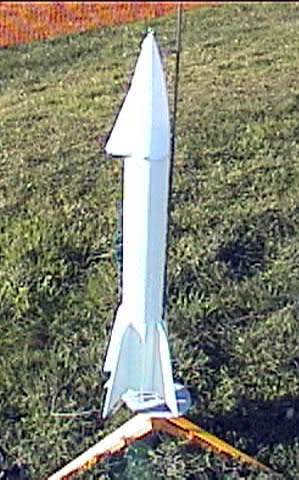
Vidroc 1.0 - flight #1

Flight Video
| format | Full speed video | Half Speed video |
| DivX .AVI | 3.1 mb | 1.6 mb |
| RealPlayer | 750k | 463k |

The launch was flawless; the signal stayed clear the entire time. The only set back was when the D12 failed to blow a suitable ejection charge to deploy the parachutes. The rest is painfully obvious.
When you watch the video, you'll hear the hollow pop of the ejection charge misfire. On the ground, we watched it nose dive into the field and could hear the camcorder's audio go to static when the rocket made impact. Luckily, it landed in a grassy field that was still soft from being watered. The circuitry of the system was fairly intact, the transmitter still works, but the camera lost a small component that prevents it from functioning. A lesson learned about marking any crash site, in case you need to return to it.
In the video, you'll see brief moments where the signal from the camera weakens. One moment is at the "turning point" where the rocket reaches apogee and heads back down. The second is just before the crash. My theory as to why this happened is related to how the antennas work with this system. They're flat plates that, when on the same plane (or perpendicular to each other), reduce the effective signal. Because the crash site was actually about 3 feet lower than the receiver, that moment before the crash, the transmitter was on the same plane to the receiver, causing the signal to deteriorate.
In the images below, there's a picture of the D-12 rocket engine's aft section showing the ejection charge cap with a tiny burn hole. I've touched up a copy of the image to demonstrate how it should have looked after the flight.
One obvious advantage to the wireless video system is that even if you have a disaster, you still have the footage.
The Crash Site
(click on
any image to enlarge)
Epilog:
Though this prototype was destroyed, the Vidroc will fly again. The concept of a low cost, low weight video system has
been "proven" and the next step is to build another prototype. This XCam
camera couldn't be salvaged but the transmitter still worked and was used in the
1.5 "updated" version of Vidroc.